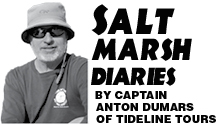The Truth About Maritime Salvage
 It’s hard to venture into the salt marsh without seeing a sunken or abandoned vessel. Most often, these vessels slip their anchor and ride a spring tide deep into the spartina grass. Once there, the vessel owner (if even aware of the event) often must wait on the next king tide to refloat and extract the vessel from the marsh. Many boats never get moved and thus become an unnatural part of the marsh-scape.
It’s hard to venture into the salt marsh without seeing a sunken or abandoned vessel. Most often, these vessels slip their anchor and ride a spring tide deep into the spartina grass. Once there, the vessel owner (if even aware of the event) often must wait on the next king tide to refloat and extract the vessel from the marsh. Many boats never get moved and thus become an unnatural part of the marsh-scape.
Passengers often ask about these abandoned vessels. Some people, who I’ll refer to as “sea lawyers,” claim that the boat becomes yours once you salvage it. I’ve never known the correct answer, so I’ve decided to find it and write about it here.
First, let’s set forth some definitions:
Wreck- Refers to anything, without an apparent owner, found afloat on, sunk in, or cast ashore by the sea.
Flotsam- Goods floating upon the sea.
Jetsam- Goods cast into the sea.
Lagan- Goods cast into the sea with a buoy or marker attached.
Derelict- refers to a vessel abandoned at sea by its guardian or owner.
Salvor- Anyone who voluntarily saves property from maritime peril.
From Admiralty lawyer John Hughes Cooper, PC:
“Salvage extends to ‘those things which have been committed to, or lost in, the sea or its branches, or other public navigable waters, and have been found and rescued (including jetsam, flotsam, and lagan).’ ”
From the Blog- WAVETRAIN:
“Under current U.S. admiralty law, which conforms to international salvage law as laid out in the Salvage Convention of 1989, assistance rendered another vessel is considered salvage when: 1) the assisted vessel is subject to a reasonable apprehension of marine peril; 2) the assistance is voluntary; and 3) the assistance is successful in whole or part.
A successful salvor is NOT entitled to just keep the salved vessel, under any circumstances, but is entitled to a generous award. The amount of the award, under the law, is based on the following factors: 1) the value of the vessel and its contents after the salvage is complete; 2) the salvor’s skill and initiative in minimizing damage to the environment; 3) the degree of success obtained by the salvor; 4) the level of peril to which the salvaged vessel was subject; 5) the salvor’s skill and initiative in saving the vessel, human lives, and other property; 6) the salvor’s labor and expenses; 7) the amount of risk run by the salvor; 8) the promptness of the services rendered; 9) the availability and use of any alternative salvage resources; and 10) the readiness, efficiency, and value of the salvor’s vessel and equipment.
In a “low-order” salvage, where the risk to a salvor is negligible and the salvaged vessel was in little danger, the premium will be relatively small, but in a “high-order” salvage the total award can, under the law, be as high as (though it may not exceed) 100 percent of the value of the salvaged vessel and its contents. Also, salvors automatically get a high-priority lien on any vessel they save and may keep the vessel until the owner posts security.
This, of course, is where the misconception comes from. If you are entitled to an award equaling 100 percent of the value of a vessel, some owners and most insurers may well propose that you simply keep the vessel, as this saves them the administrative and transactional costs of selling it to pay you off. Even if you don’t want the vessel, they can force the situation by not paying you, thereby compelling you to seize the boat.”
So … There’s the answer. If one sees a vessel presumably abandoned or in peril, then volunteers to “save” that vessel, and does so with little damage to the vessel, a claim could be made. Just make sure you really want the vessel, because it may become your liability whether you want the boat or not.
Anton DuMars, owner of Tideline Tours, is a long-time Folly resident and coastal geologist. Come explore the salt marsh aboard the TIDELINE. Visit www.tidelinetours.com or call 843-813-5009

